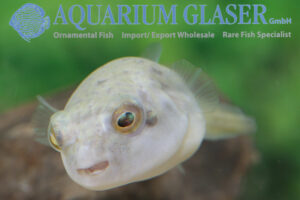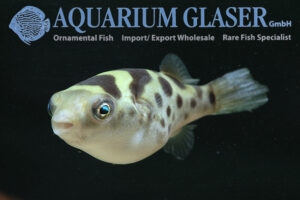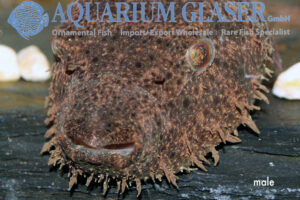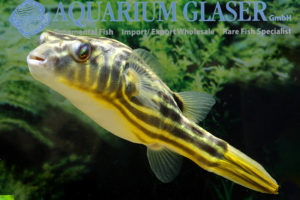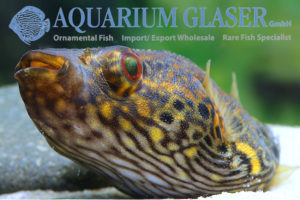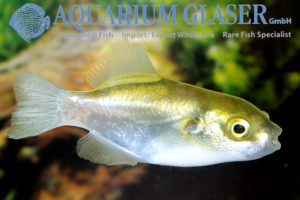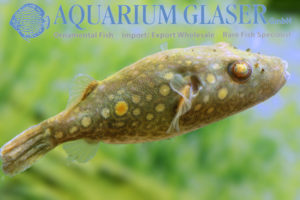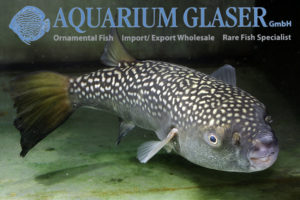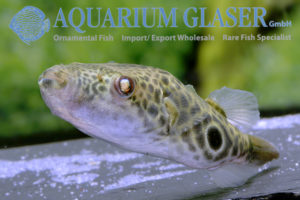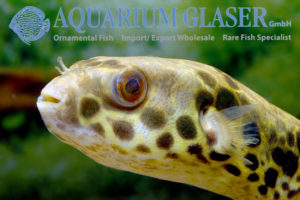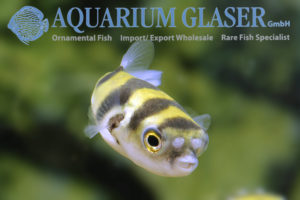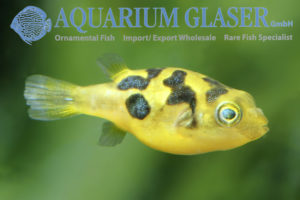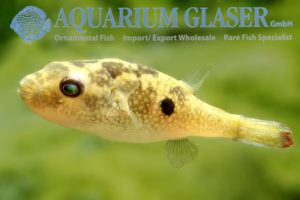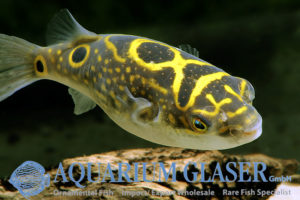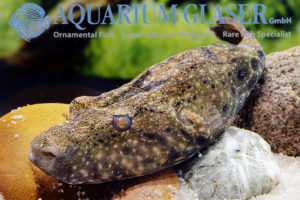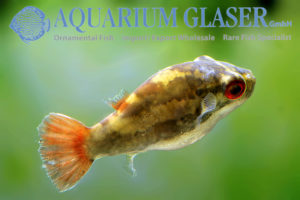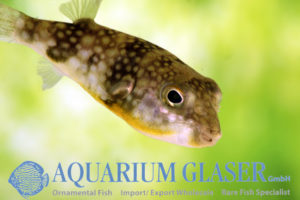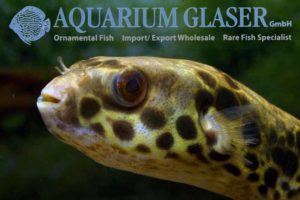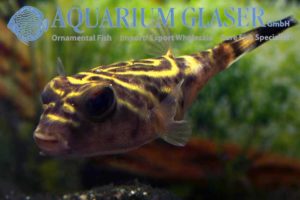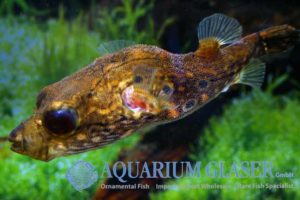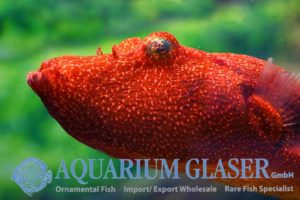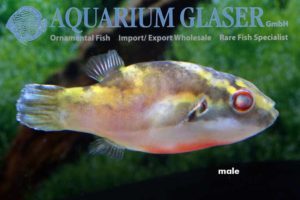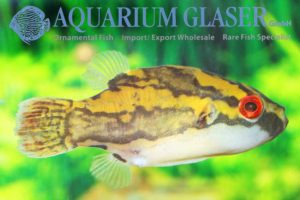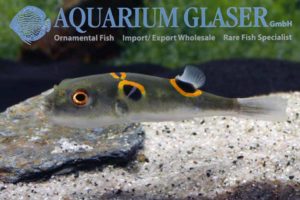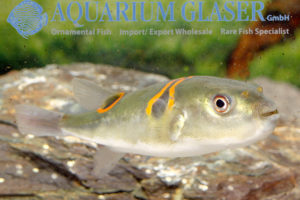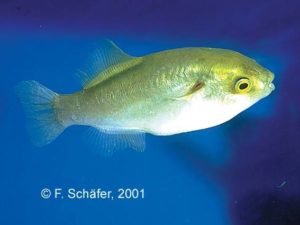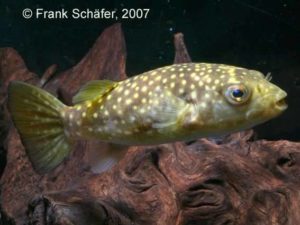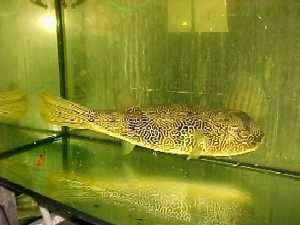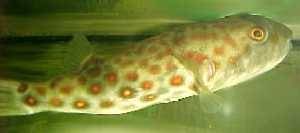The up to 40 cm long Nile pufferfish (Tetraodon lineatus) is a magnificent freshwater species from Africa. We have presented it in detail here: https://www.aquariumglaser.de/fischarchiv/tetraodon-lineatus-15-20-cm/ For some time now, we have also bred specimens of this species from Indonesia in stock. In Nigeria – the home of these fish – fewer and fewer people want […]
27. Puffers (31)
-
-
Dichotomyctere fluviatilis (formerly: Tetraodon fluviatilis)
The Green Puffers have been recently splitted from the catch-all genus Tetraodon and placed in a genus on their own, namely Dichotomyctere. Usually three diffenent species can be found in the trade: the Palembang or Figure-8-Puffer (D. ocellatus, formerly known as Tetraodon biocellatus), the Spotted Green Puffer (D. nigroviridis), and the Real Green Puffer (D. […]
-
Pao baileyi ( = Tetraodon baileyi)
From time to time we can import what is probably the strangest of all freshwater puffer fish: Pao baileyi. This species occurs in the rapids of the river Mekong in Thailand, Laos, and Cambodia and has been discovered only in 1985. The species attains a maximum length of about 12-15 cm. The strange beard that […]
-
Tetraodon lineatus 15-20 cm
The very first puffer fish to receive a scientific name valid in today’s sense was the Nile puffer fish, Tetraodon lineatus. This was in 1758 and is not at all surprising, because the scholars of the world knew the fish since ancient times. In ancient Egypt there was even a hieroglyph in the form of […]
-
Pao palembangensis (= Tetraodon palembangensis)
Every now and then we can import this incredible freshwater pufferfish in small numbers. It is a very specialized species that only occurs in nature in Sumatra and Borneo, where it inhabits very soft, acidic water. This puffer fish is a purely freshwater species, never frequenting brackish or seawater. The strangely colored belly is used […]
-
Auriglobus modestus
The golden pufferfishes – the genus name Auriglobus means roughly “golden globe“ – are pure freshwater pufferfishes. For a long time it was thought that there was only one species, A. modestus, which was placed in the genus Chonerhinos. Then it was discovered that there are actually five species, darn similar to each other. We […]
-
Pao abei (formerly Tetraodon abei)
This beautiful and – by Pao standards – peaceful freshwater pufferfish originates from the Mekong River basin in Laos (type locality: the Xe Bangfai River near Ban Geng Sahwang); it is considered endemic (= only occurring there) in the Xe Bangfai. In contrast to Pao turgidus, which occurs in the same river, P. abei has […]
-
Chelonodontops bengalensis
Large puffer fish are always a cause for joy among our staff. The animals are not only beautiful, but they communicate with the keeper and the hall visitors. Their eyes are always in lively motion and it is difficult to avoid the impression that the fish in the aquarium looks at the person outside the […]
-
Pao sp. Chao Phraya
The cockade pufferfishes are a very complex group of freshwater pufferfishes. Formerly they were called the “Tetraodon-leiurus group”, but since 2013 they are in the genus Pao. The genus name Tetraodon is now only applied to the freshwater puffers of Africa. Throughout Southeast Asia (Thailand, Laos, Cambodia, Vietnam, Malaysia, Singapore, Indonesia), Pao freshwater puffers can […]
-
Tetraodon schoutedeni
In the 1960s Tetraodon schoutedeni was one of the most common freshwater puffers in the trade. Also the breeding of the animals succeeded regularly. The fish are free spawners without brood care. But the civil war in Congo changed the situation drastically and even nowadays catchers are reluctant to go to the occurrence areas of […]
-
Pao abei (formerly: Tetraodon or Monotrete abei)
In Southeast Asia a group of freshwater puffers exists that is extremely difficult to tell apart on a specific level. They are called the Eyespot-Puffers or the Pao-leiurus-complex. These puffers live in streams and rivers, some also in ponds and lakes, always in pure freshwater. Among the most enigmatic species is Pao abei, which has […]
-
Colomesus asellus
The South American puffer fish Colomesus asellus are ideal for aquarium care. They remain small (usually around 6-8 cm, at most around 12 cm, other sizes given in the literature are based on confusion), are pure freshwater inhabitants, love to eat small snails and are absolutely peaceful, both against conspecifics and against other fish species. […]
-
Carinotetraodon travancoricus
The first Indian dwarf puffer fish (Carinotetraodon travancoricus) of the new season have arrived. These cute animals – they are freshwater puffers – only grow 2-3 cm long in nature, in the aquarium they may grow a little bigger, but not much. You should keep these animals in a swarm if possible; then they form […]
-
Leiodon cutcutia THAILAND
The first tropical freshwater puffer fish, which was imported in 1903 for aquaristics and soon bred, was the common or emerald puffer fish, at that time still known as Tetraodon cutcutia. The species remains quite small with a maximum length of 9 cm, is attractively colored and easy to keep, but unpredictably biting against conspecifics […]
-
Dichotomyctere ocellatus (formerly: Tetraodon biocellatus)
The green pufferfish (genus Dichotomyctere) are the best known aquarium pufferfish. They are brackish water animals, which, in case they should be cared for in fresh water, paying special attention to their pH value. A pH below 8 does not get them in the long run and the water should be as hard as possible. […]
-
Pao suvattii (= Tetraodon suvattii)
This freshwater pufferfish originates from the rivers of Thailand. Here it imitates stones and lurks for clueless feeder fish. In the aquarium it can be easily fed by large pieces of frozen food given by a forceps. The fish becomes around 12-15 cm long and looks very much alike the African cousin Tetraodon miurus. However, […]
-
Carinotetraodon irrubesco
Pufferfish are most often thought to be brackish water fishes. But there do exist indeed species that are adopted to totally fresh water. Some of them even live in the very soft and acidic waters of the forests. Among the latter are the species of Carinotetraodon from Indonesia; we currently could import once more C. […]
-
Chelonodon patoca
We received this beautiful species of brackish water puffer from Thailand. The species Chelonodon patoca has a wide distrubution in the Indian Ocean. It is often placed in the genus Chelonodontops in recent times. Adult specimens – the species becomes up to 30 cm long – usually live in the sea, while young fish live […]
-
Tetraodon schoutedeni
Long time not seen! Formerly, in the 1960ies, Tetraodon schoutedeni was one of the most common species in the ornamental fish trade. Even breeding of this species proofed to be rather uncomplicated. But due to the civil wars in the Congo the situation changed drastically. Even nowadays the collectors prefer not to go to the […]
-
Sphoeroides annulatus
A very interesting species of pufferfish reached us currently from Colombia: Sphoeroides annulatus. This species is primary a seawater fish, but juveniles are often found in pure freshwater. However, we recommend to keep the species in brackish water. This beautiful puffer can reach a maximum length of 40 cm. Most specimens are peaceful, but one […]
-
Pao palembangensis and Dichotomyctere ocellatus
Pao palembangensis (= Tetraodon palembangensis) Once more we were able to import a small number of the most unbelievable freshwater pufferfish. This species is quite specialized. It occurs only on Sumatra and Borneo, where it lives in very soft and acidic water. This puffer is a pure freshwater species that never enters brackish or marine […]
-
Tetraodon miurus
The Congo Puffer is one of the most remarkable species of freshwater pufferfish at all. The strictly solitary living species is a predator. It prefers to spend the day completely burrowed in sand. Only the mouth and the eyes peep out of the lair. If a potential prey comes along the puffer shoots out of […]
-
Carinotetraodon borneensis
This pufferfish lives exclusively in pure freshwater on Borneo and is only very rarely imported. The maximum length is about 6 cm (males) and 4 cm (females). In the wild this fish lives in soft and acidic water! For our customers: the animals have code 408102 on our stocklist. Please note that we exclusively supply […]
-
Carinotetraodon borneensis
At least we successfully imported one of the most mysterious species of freshwater pufferfish: Carinotetraodon borneensis. Although the species as been described already in 1903, it was considered over decades as a junior synonym of a closely related species, C. lorteti. However, both species look extremely similar in alcohol. In live the fish look quite […]
-
Takifugu ocellatus
After many long years we were finally able again to import this most beautiful pufferfish. For more informations on the species, please see http://www.aquariumglaser.de/en/archiv.php?news_id=207 For our customers: the animals have code 456363 on our stocklist. Please note that we exclusively supply the wholesale trade. Text & photos: Frank Schäfer
-
Takifugu ocellatus
We were able to import one of the most beautiful freshwater puffers from China again: Takifugu ocellatus. This fish shows us that the terms “freshwater fish” and “marine fish” can be applied on the very same species. Like salmon these puffers live in pure freshwater during their youth and then go to the sea where […]
-
Auriglobus silus
(21.Dec.2007) Streched Puffer is his name. This week we recieved this frisky puffer from Thailand. They are easy to keep and do not need special water parameters. In bigger sizes they can tend to fight between themselves. All in all it is an interesting puffer, which will be kept mainly from experts or experienced hobbyists. […]
-
FIRST TIME IMPORTED: Arothron firmamentum
Just yesterday we got from Burma an marine pufferwhich was caught in pure freshwater: Arothron firmamentum. This is the first time that this item was found in freshwater and we hope that we can provide more details about them soon.
-
Tetraodon mbu
April 2002: Yesterday we received from the Republic of Congo, this beautiful Tetraodon mbu, the real congo-puffer. We got this item in this huge size never before.The maximum size cited in the literature is nearly 70cm. It is astounding how individuals differ in their behaviour: there are shy and also agressive ones. More details you […]
-
Tetraodon pustulatus
TETRAODON PUSTULATUS was caught in Cross-River in Cameroon. External shape and behaviour of adult animals remind one of Tetraodon mbu. The maximum size is quoted with 36cm in literature. Young animals being kept together do not show any injuries so that it is safe to assume that they are not very aggressive. Tetraodon pustulatus has […]
New generic names for freshwater pufferfish (1)
Until
recently most species of freshwater puffer from Africa and Asia have
been placed in the genus Tetraodon. Currently this concept changes. The
name Tetraodon is restricted now to the six species of freshwater puffer
occuring in Africa, namely Tetraodon duboisi, T. lineatus, T. mbu, T.
miurus, T. pustulatus and T. schoutedeni. All other species are placed
in different and often new genera; we will introduce all these changes
to you in the upcoming weeks.






We
have currently three species of African pufferfish in stock: T.
lineatus from Nigeria; from the Congo originate T. miurus (we have them
in different colours) and T. mbu (we have different sizes).
For
our customers: T. lineatus has code 190305, T. miurus 191303 and T. mbu
191000 and 191004 on our stocklist. Please note that we exclusively
supply the wholesale trade.
Text & photos: Frank Schäfer





